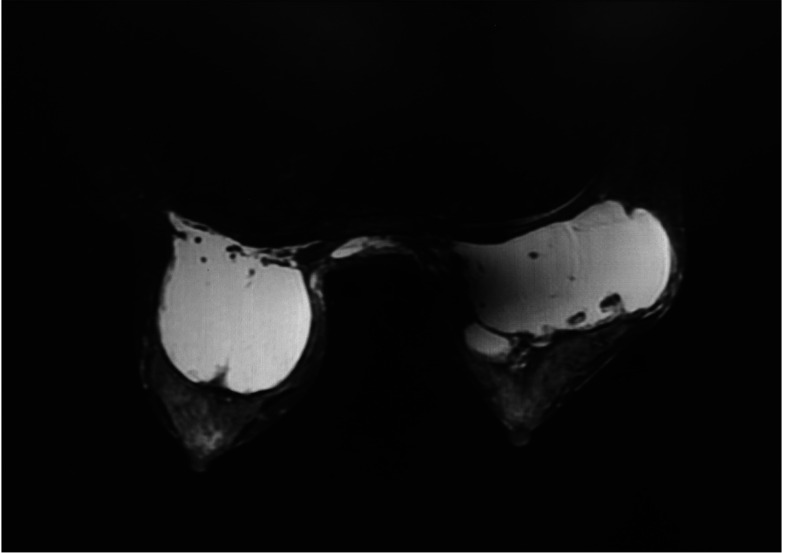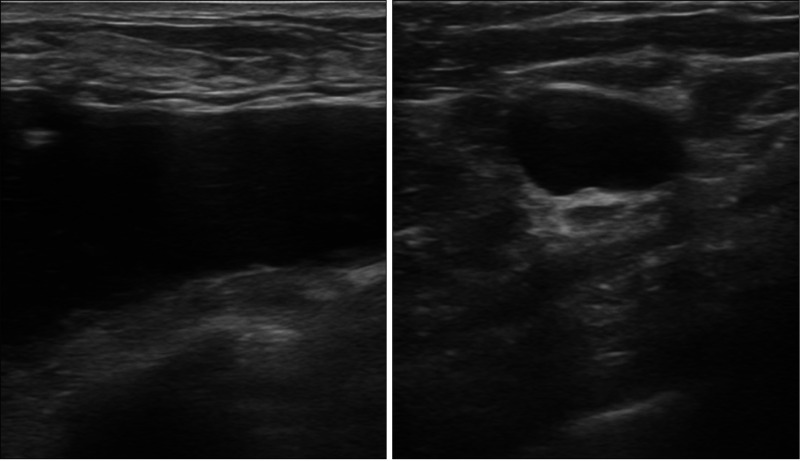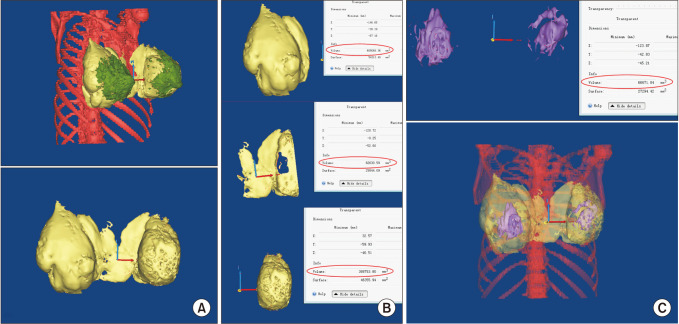Ann Surg Treat Res.
2024 Jan;106(1):31-37. 10.4174/astr.2024.106.1.31.
Application of magnetic resonance imaging with intraoperative color Doppler ultrasound in the treatment of patients with polyacrylamide hydrogel injected for breast augmentation: a retrospective study of 204 cases for 12 years
- Affiliations
-
- 1Department of Plastic Surgery, Peking University Third Hospital, Beijing, China
- KMID: 2550248
- DOI: http://doi.org/10.4174/astr.2024.106.1.31
Abstract
- Purpose
Polyacrylamide hydrogel (PAHG), which had been used widely for breast augmentation, has been banned for more than 15 years. Patients who had been injected PAHG for breast augmentation need evacuation surgery to remove as much as possible. To provide a series of diagnosis and treatment process MRI and intraoperative color Doppler ultrasound are combined for maximal removal of PAHG.
Methods
The patients who received evacuation surgery in Peking University Third Hospital from 2010 to 2022 after PAHG injection for breast augmentation were included in this research. MR scanning was performed preoperatively and postoperatively in some of these patients and color Doppler ultrasound was applied to help evacuate PAHG intraoperatively. The mean clearance rate of PAHG was calculated according to the MRI outcomes.
Results
Two hundred and 4 patients had received evacuation surgery after PAHG injection for breast augmentation with an average age of 42.8 years and an average body mass index of 21.2 kg/m 2 . The average PAHG retention time was 13.5 years. Among them, 52 patients underwent pre- and postoperative MRI scanning. The mean three-dimensional (3D) volume of PAHG was 684.8 mL (range, 350.0–1,123.9 mL), and the average residual 3D volume of PAHG was 53.7 mL (range, 12.4–98.3 mL). The mean clearance rate was 92.1%.
Conclusion
MRI and intraoperative color Doppler ultrasound can provide effective and precise location information of PAHG for evacuation surgery, which is a reliable method to ensure the maximal removal of PAHG.
Figure
Reference
-
1. Xi TF, Fan CX, Feng XM, Wan ZY, Wang CR, Chou LL. Cytotoxicity and altered c-myc gene expression by medical polyacrylamide hydrogel. J Biomed Mater Res A. 2006; 78:283–290. PMID: 16637045.2. Wang ZX, Luo DL, Dai X, Yu P, Tao L, Li SR. Polyacrylamide hydrogel injection for augmentation mammaplasty: loss of ability for breastfeeding. Ann Plast Surg. 2012; 69:123–128. PMID: 21785335.3. Khan UD. Breast autoinflation with sterile pus as a marker of implant rupture: single-stage treatment and outcome for 5 consecutive cases. Aesthetic Plast Surg. 2009; 33:58–65. PMID: 18712438.
Article4. Zhang MX, Li SY, Xu LL, Zhao BW, Cai XY, Wang GL. Repeated lumps and infections: a case report on breast augmentation complications. World J Clin Cases. 2019; 7:3322–3328. PMID: 31667186.5. Cheng NX, Liu LG, Hui L, Chen YL, Xu SL. Breast cancer following augmentation mammaplasty with polyacrylamide hydrogel (PAAG) injection. Aesthetic Plast Surg. 2009; 33:563–569. PMID: 19156460.6. Jin R, Luo X, Wang X, Ma J, Liu F, Yang Q, et al. Complications and treatment strategy after breast augmentation by polyacrylamide hydrogel injection: summary of 10-year clinical experience. Aesthetic Plast Surg. 2018; 42:402–409. PMID: 29124374.7. Chen L, Sha L, Huang SP, Li SR, Wang ZX. Treatment for displacement of PAAG mixture after injection augmentation mammoplasty. Int J Clin Exp Med. 2015; 8:3360–3370. PMID: 26064226.8. Luo SK, Chen GP, Sun ZS, Cheng NX. Our strategy in complication management of augmentation mammaplasty with polyacrylamide hydrogel injection in 235 patients. J Plast Reconstr Aesthet Surg. 2011; 64:731–737. PMID: 21074506.9. Zhang F, Wang X, Guo H. Different types of breast deformity induced by 2 types of polyacrylamide hydrogel and corresponding treatment. Aesthetic Plast Surg. 2020; 44:726–734. PMID: 32002578.10. Hu J, Liu C, Chen L, Xing W, Luan J. Volumetric measurement of polyacrylamide hydrogel injected for breast augmentation using magnetic resonance imaging. Exp Ther Med. 2014; 7:681–684. PMID: 24520267.11. Qian B, Xiong L, Guo K, Wang R, Yang J, Wang Z, et al. Comprehensive management of breast augmentation with polyacrylamide hydrogel injection based on 15 years of experience: a report on 325 cases. Ann Transl Med. 2020; 8:475. PMID: 32395519.
- Full Text Links
- Actions
-
Cited
- CITED
-
- Close
- Share
- Similar articles
-
- Long-term Complications from Breast Augmentation by Injected Polyacrylamide Hydrogel
- Augmentation Mammoplasty Using Polyacrylamide Hydrogel Injection Can Mimic Breast Cancer After 20 Years: A Case Report
- Ultrasonographic and Mammographic Findings of Polyacrylamide Gel Injection Mammoplasty: A Case Report
- Complications of polyacrylamide hydrogel injection for breast augmentation: A case report and literature review
- Clinical Features after Rupture of Hydrogel Breast Implants - MDbP206




